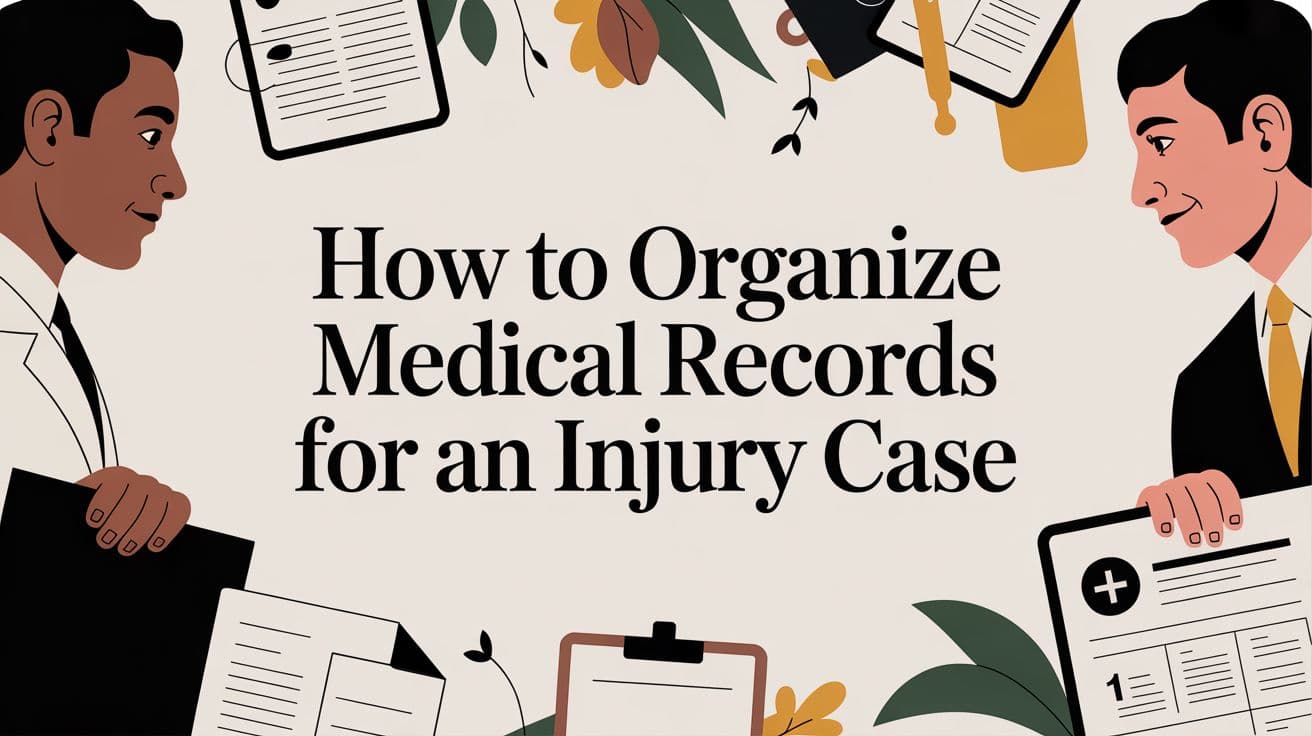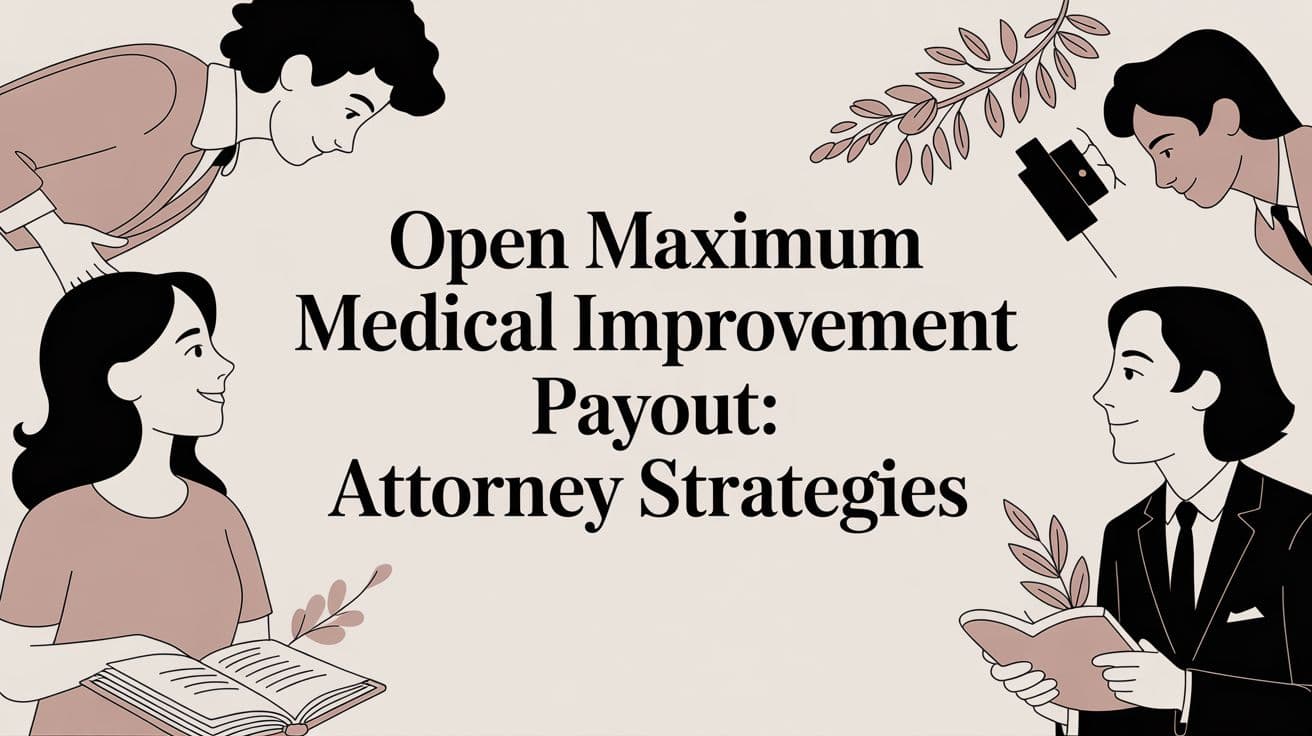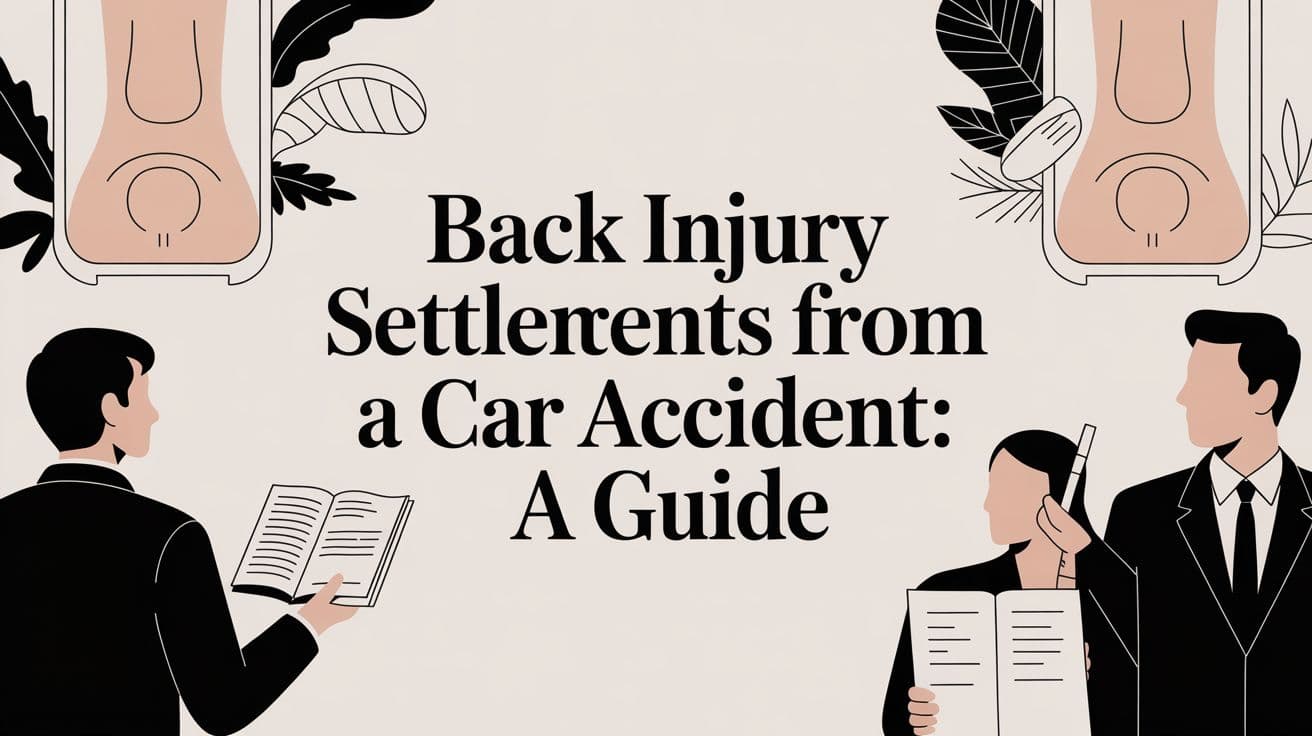Emotional Pain and Suffering Settlement Guide
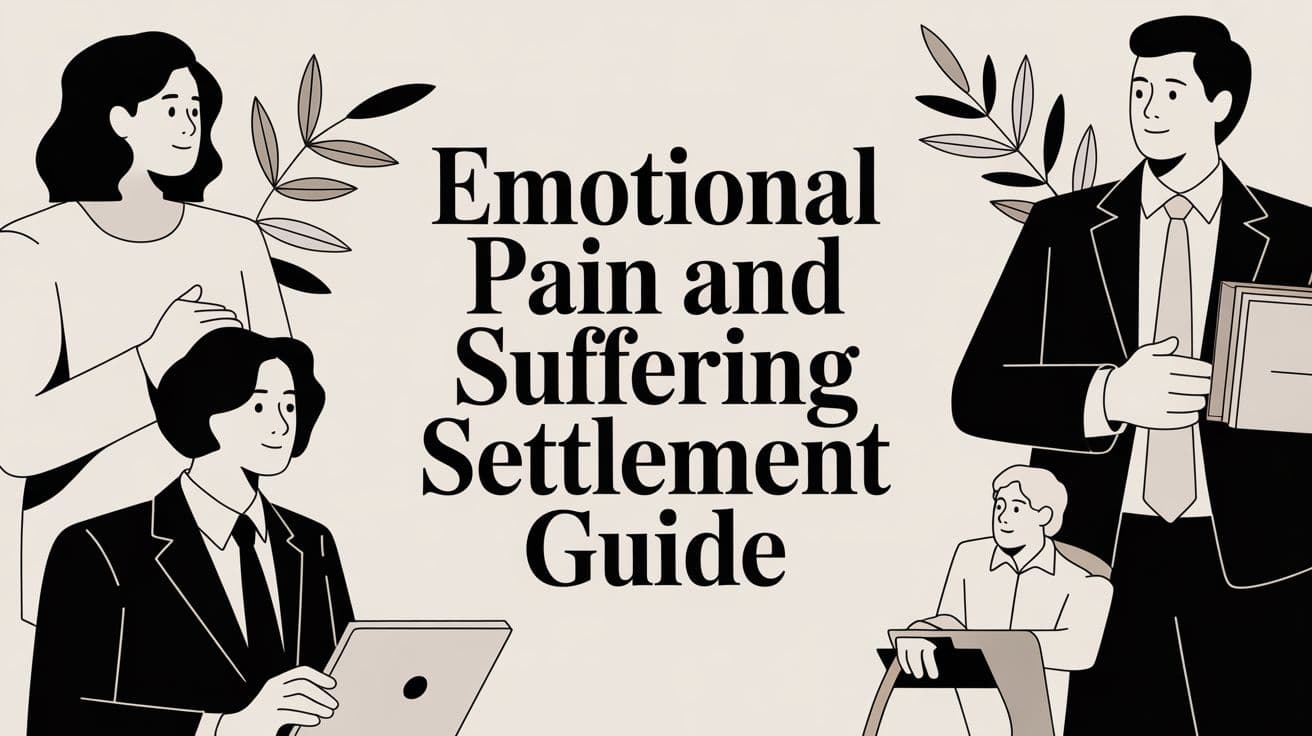
An emotional pain and suffering settlement is the money you receive for the invisible harm an injury causes—the anxiety, depression, fear, and loss of enjoyment that follow a traumatic event. These aren't like medical bills with a clear price tag. They're intangible, which makes putting a dollar figure on them one of the most challenging parts of any personal injury claim.
What Does "Pain and Suffering" Actually Mean in a Lawsuit?
When you pursue a personal injury claim, you're asking for compensation, which lawyers call "damages." These damages are broken down into two distinct buckets. The first covers the clear, out-of-pocket costs you can track with receipts. The second, however, gets at the very real, but invisible, human cost of your injury.
Emotional pain and suffering fits neatly into this second category, officially known as non-economic damages.
Think of it this way: a shattered femur is the physical injury. But the panic attacks you now get when you see a car turn left, the sleepless nights spent replaying the accident, or the frustration of not being able to pick up your kids—those are the emotional wounds. The law acknowledges that this kind of suffering is just as real as a hospital bill and deserves to be compensated.
Economic vs. Non-Economic Damages at a Glance
To really get a handle on where emotional distress fits, it helps to see the two types of damages side-by-side. One is about paying you back for direct financial losses, while the other is about acknowledging the profound impact on your quality of life.
| Damage Type | Definition | Examples |
|---|---|---|
| Economic Damages | The specific, verifiable financial losses you incurred because of the injury. These have a clear paper trail. | • Medical Bills • Lost Wages • Property Damage • Future Medical Costs |
| Non-Economic Damages | The subjective, non-financial losses related to your quality of life and mental well-being. These are intangible. | • Emotional Distress • Anxiety & Depression • Loss of Enjoyment of Life • Loss of Companionship |
At its core, the legal system aims to make you "whole" again after an accident, and that means more than just covering your expenses. An emotional pain and suffering settlement is designed to address these deep, life-altering impacts.
The Two Sides of Damages
To really get a handle on this, you need to understand the two main types of damages. One is all about reimbursement; the other is about acknowledging your human suffering.
Economic Damages: These are the straightforward, calculable financial losses. Think of things like your hospital bills, the income you lost from being unable to work, and the cost of repairing your car. Each one has a clear dollar value tied to it.
Non-Economic Damages: This is where emotional pain and suffering lives. It covers the abstract, subjective losses that don't come with a neat invoice—like mental anguish, persistent fear, loss of companionship, and a general decline in your quality of life.
The legal system gets that making you "whole" again after an accident involves more than just paying your bills. An emotional pain and suffering settlement is designed to compensate you for these profound, life-altering impacts. This is especially true after events like car accidents, where the emotional toll can be immense. Resources on ICBC counselling after a car accident show just how critical addressing this psychological fallout is.
Key Takeaway: While economic damages cover your financial losses, non-economic damages are intended to compensate for the human suffering you experience. A fair settlement must account for both to truly address the full scope of your harm.
It's also worth noting that the landscape for these settlements is always changing. The value of claims can shift due to new laws, economic factors, and how courts interpret what's fair for intangible harm. These settlements are all about compensating for psychological trauma and the loss of life's joys, which are far trickier to prove than a broken bone. This makes building your case with solid, organized evidence more critical than ever.
How Pain and Suffering Settlements Are Calculated
So, how do you put a price tag on something as intangible as pain and emotional anguish? It’s one of the trickiest parts of any personal injury claim. There’s no simple invoice for anxiety or a receipt for trauma. Instead, lawyers and insurance companies use a few established methods to translate that very real, human suffering into a dollar figure for your emotional pain and suffering settlement.
It's important to know that no formula is perfect, but these calculations create a necessary starting point for negotiations. Understanding how they work is the key to setting realistic expectations and knowing a fair offer when you see one. The two most common frameworks are the Multiplier Method and the Per Diem Method.
The journey from the initial injury to a final settlement figure involves several stages, with each step building on the last to paint a complete picture of your total damages.
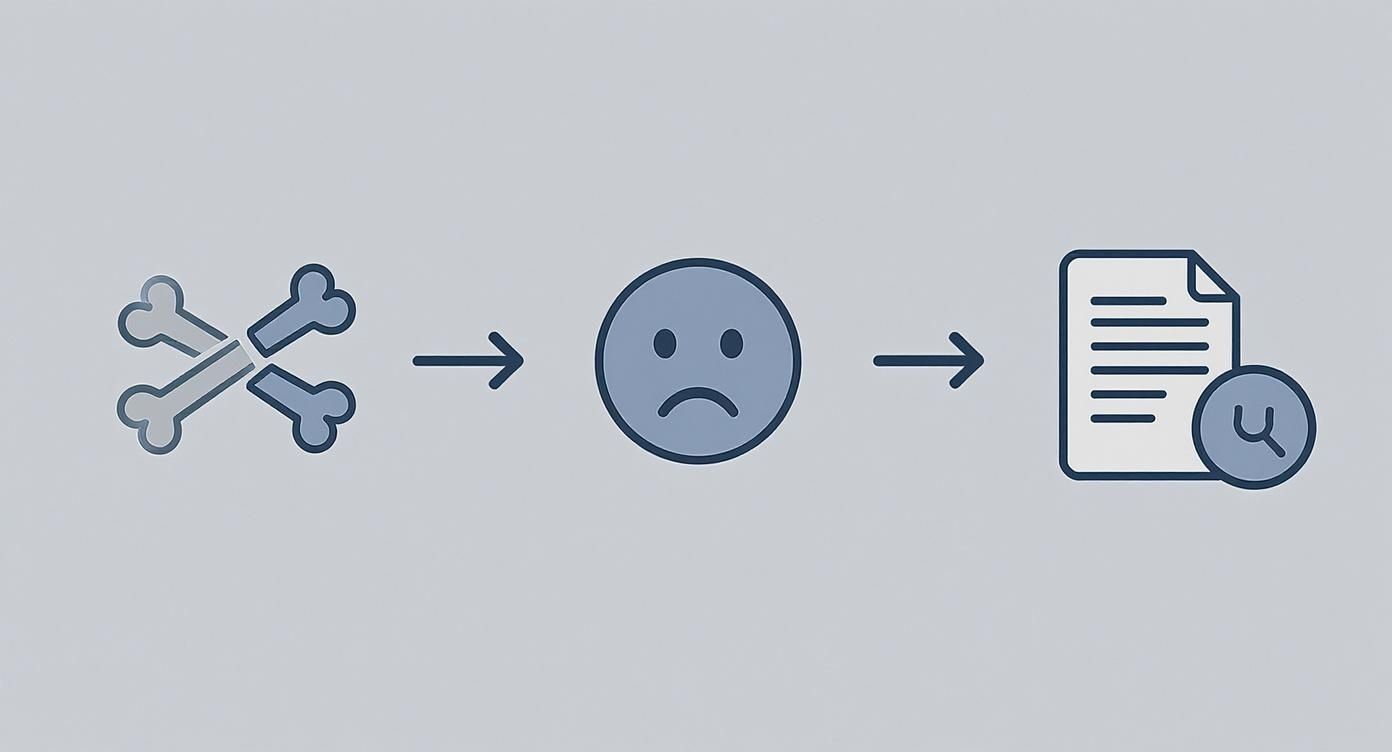
This visual helps show how the physical injury leads to emotional fallout, which then forms the basis of the legal claim seeking compensation for both.
The Multiplier Method Explained
The Multiplier Method is, by far, the most common approach you'll see in the legal world. The concept is straightforward: you take the total of your concrete, easily-calculated economic losses—things like medical bills and lost wages—and multiply that number by a factor, usually somewhere between 1.5 and 5.
This "multiplier" is where the art of negotiation comes in. It isn't just a random number; it's a reflection of how severe the injury was and how deeply it impacted your life.
- A multiplier of 1.5 to 2 is typical for more minor injuries with a quick recovery—think sprains or bruises that heal in a few weeks with minimal life disruption.
- A multiplier of 3 to 4 is often applied to more serious situations, like a broken bone or a concussion that demands months of treatment and causes significant pain and lifestyle changes.
- A multiplier of 5 (or even higher) is reserved for catastrophic, life-altering events that result in permanent disability, chronic pain, severe disfigurement, or profound psychological trauma.
Let’s say your medical bills and lost income add up to $20,000. If the injury was a severe fracture that required surgery and left you with persistent anxiety about your future mobility, your attorney would likely argue for a multiplier of 4. The math would put your pain and suffering damages at $80,000 ($20,000 x 4).
Key Insight: The multiplier is more than just a number; it’s a narrative. It tells the story of your pain's intensity, the length of your recovery, the permanence of your injuries, and the overall toll the incident took on your quality of life.
The Per Diem Method Explained
Another, less common, approach is the Per Diem Method. "Per diem" is just Latin for "per day." This technique assigns a daily dollar amount to your suffering and multiplies it by the number of days you were in pain.
How is the daily rate determined? It's often anchored to a figure that's easy to justify, like your daily earnings. The argument is simple: the work of enduring your pain and focusing on recovery is at least as demanding as your regular job.
For instance, if you earned $200 per day and your recovery took 150 days, the per diem calculation would look like this:
$200 (daily rate) x 150 (days of recovery) = $30,000 for pain and suffering.
This method is most effective for injuries with a clear and definable recovery period. It starts to fall apart for long-term or permanent injuries where you can't possibly put an end date on the suffering. It can also undervalue the suffering of people who are unemployed or earn a low income.
Choosing the Right Method for Your Claim
In reality, a good attorney will often run the numbers using both methods. This gives them a reasonable settlement range to bring to the negotiating table. The Multiplier Method is generally favored because it’s better at capturing the severity of an injury, while the Per Diem Method provides a simple, concrete justification for short-term suffering.
Ultimately, these formulas are just tools for negotiation, not iron-clad rules. The insurance adjuster will always push for a lower multiplier or a shorter recovery timeline. Your legal team’s job is to use the evidence to justify a higher, fairer figure.
For a deeper dive into this process, check out our complete guide on how to calculate emotional distress damages. Understanding how these numbers come to life is the first and most critical step in advocating for the compensation you truly deserve.
How to Build a Rock-Solid Case for Emotional Distress
Figuring out what your claim is worth is just one side of the coin. The other, more critical side, is proving it. In the eyes of the law, your pain is absolutely real, but turning that pain into a settlement requires hard evidence. Always remember, an insurance adjuster's job is to pay out as little as possible, and they will pounce on any claim that isn't backed by solid proof.
Think of it like building a fortress. Your own story of what you've gone through is the foundation. But that foundation needs to be reinforced with thick walls of objective, verifiable evidence. The stronger your documentation, the less room an adjuster has to argue.

Let's walk through the playbook for gathering the kind of powerful evidence that makes your claim undeniable.
Your Medical and Mental Health Records are Your Cornerstone
The most compelling evidence you can have comes straight from medical professionals. They can officially connect the dots between the incident and the psychological harm you’re suffering. These records offer a clinical, unbiased view that is incredibly difficult to dispute.
- Therapy and Counseling Notes: These are pure gold. Records from a psychologist, therapist, or counselor chronicle your symptoms—anxiety, depression, PTSD, insomnia—and show a clear timeline of your treatment and progress.
- Psychiatric Evaluations: A formal diagnosis from a psychiatrist carries immense weight. If you've been prescribed medications like antidepressants or anti-anxiety drugs, that’s black-and-white proof of a diagnosed condition.
- Your Doctor's Notes: Don't underestimate the records from your family doctor. Every time you mention you're having trouble sleeping, feeling a spike in anxiety, or experiencing other emotional symptoms, it gets noted and becomes part of a consistent medical story.
These records are the bedrock of your claim. This is why it’s so important to be completely open with your healthcare providers about every single thing you’re feeling.
The Power of Your Own Words: Personal Documentation
While medical records give the clinical perspective, your own documentation tells the human story. A simple daily or weekly journal can be one of the most persuasive tools in your arsenal.
A journal turns abstract feelings into a tangible logbook. It creates a clear "before and after" picture of your life, showing exactly how the injury has chipped away at your happiness and ability to function.
Use a journal to track the details:
- Your daily pain levels and how they crush your mood.
- The sleepless nights, nightmares, or flashbacks.
- Moments of panic, sudden anxiety, or crying spells.
- The hobbies you can't do anymore or the family events you had to miss.
- The strain this has put on your relationships with your partner, kids, or friends.
Keeping this record consistently is key. It’s a contemporaneous account—you’re writing things down as they happen, which is far more credible than trying to remember the details six months down the line.
Let Others Tell Your Story: Witness Testimony
Sometimes, the most powerful proof comes from the people who see you every day. Testimony from family, close friends, or even coworkers can paint a vivid picture of the "new you" since the incident.
They can speak to changes they've witnessed firsthand, like:
- How you went from being the life of the party to someone who never wants to leave the house.
- How your once-patient demeanor has been replaced with irritability.
- How you’ve lost all interest in the passions that used to define you.
A statement from a spouse describing your new fear of getting in a car, or a note from a friend explaining that you no longer join them for your weekly golf game, can be incredibly moving. Their observations back up your own account and add another layer of authenticity to your claim.
Speeding Up the Process with Modern Tools
Let’s be honest: sifting through hundreds of pages of medical records to find the key pieces of evidence is a monumental task. This is where legal tech now offers a huge advantage. AI-powered platforms can scan and analyze massive document files in minutes, pulling out the exact information you need.
These tools can instantly flag:
- Diagnoses of conditions like PTSD or Acute Anxiety Disorder.
- All prescribed medications and their corresponding treatment timelines.
- Every note where a doctor mentions a complaint of emotional distress.
- Language that creates a causal link between the accident and your psychological symptoms.
By automating the tedious review process, attorneys can piece together a clear, evidence-based story without billing for dozens of hours of manual work. For any team tackling this, knowing how to organize medical records is the first step, and using the right tools is the second. An organized case file is a persuasive one.
At the end of the day, proving emotional distress is all about weaving together a consistent, credible story from multiple angles. When you combine professional medical opinions, your own detailed journal, and testimony from the people who know you best, you build a case that’s simply too strong to ignore. This is how you pave the way for a fair emotional pain and suffering settlement.
How State Laws and Damage Caps Impact Your Settlement
https://www.youtube.com/embed/6en9UZ8Ee38
After you’ve built a strong case and figured out what your damages might be worth, you’ll run headfirst into a factor you can’t control: geography. Where your injury happened can completely change the value of your emotional pain and suffering settlement. This isn't just a technicality; it’s a game-changer dictated by state law.
Every state plays by its own rulebook when it comes to personal injury claims. That means the exact same accident, with the exact same injuries, could lead to wildly different outcomes just because one happened in Nevada and the other in California. Knowing the specific laws in your state is absolutely crucial for setting realistic expectations and building a smart legal strategy.
Understanding Damage Caps
The biggest state-level hurdle you might face are damage caps. Think of these as legal ceilings that some states put on the amount of money you can receive for non-economic damages. Since emotional pain and suffering falls squarely into that category, these caps can put a hard stop on your potential compensation.
Why do these caps exist? They're often put in place to keep insurance premiums down and prevent what some legislators consider runaway jury awards. For the person who's actually injured, however, a cap can feel incredibly unfair, especially when their suffering is severe and long-lasting.
Here’s a quick breakdown of how these caps usually work:
- Fixed Caps: Some states just set a flat limit. For example, a state might cap non-economic damages in a medical malpractice case at $250,000, no matter how devastating the emotional toll was.
- Tiered Caps: Other states use a more nuanced approach. They might have a lower cap for standard injuries but a higher one for catastrophic events like paralysis or permanent disfigurement.
- No Caps: Thankfully, many states have no caps on non-economic damages for most personal injury cases. This leaves it up to a jury to decide what’s fair based on the evidence presented.
This patchwork of laws creates huge differences from one state to the next. A case in a no-cap state might result in a multi-million-dollar award for pain and suffering, while the same case in a state with a strict cap could be limited to a small fraction of that.
The Real-World Impact of State Laws
Let’s make this real. Imagine two people are in similar car accidents. Both go through months of painful rehab and are diagnosed with PTSD. One accident took place in Texas, which doesn’t cap non-economic damages for most car accidents. The other happened in Colorado, which does.
The potential settlement for the victim in Texas is, in theory, unlimited—it’s based on what a jury believes is fair. But the Colorado victim’s compensation for the very same suffering could be legally restricted by a statutory limit, which might only be a few hundred thousand dollars.
This is exactly why one of the first questions any good personal injury lawyer asks is, "Where did the accident happen?" The answer to that single question draws the legal boundaries for the entire claim.
Knowing your state’s rules on damage caps isn’t just helpful; it’s non-negotiable. It shapes everything from the initial demand letter to the final negotiation, setting the stage for what’s truly possible in your emotional pain and suffering settlement.
Proven Negotiation Strategies for a Fair Settlement

You’ve organized your evidence and calculated your damages. Now comes the part where the rubber meets the road: negotiation. This is where you turn all your hard work and documentation into a fair emotional pain and suffering settlement. It can feel intimidating, but a solid strategy allows you to advocate confidently for the compensation you truly deserve.
Your first move is to draft a compelling demand letter. Think of this as more than just a request for money; it's the opening argument for your case. It needs to tell a story that connects the dots for the insurance adjuster, clearly showing how the accident led not just to physical injuries, but to the deep emotional toll you've experienced. A strong demand letter sets the tone for everything that follows.
For a detailed walkthrough on how to make your opening statement as effective as possible, our guide on writing a demand letter for personal injury offers practical steps and examples. Getting this right can dramatically influence the adjuster's first offer.
Countering Common Adjuster Tactics
Insurance adjusters are skilled negotiators. Their job is to protect their company's bottom line by minimizing payouts. To do this, they often rely on a familiar playbook of tactics designed to make you question your own claim and accept a lowball offer.
Knowing their game plan is the first step to beating it. Be ready for them to:
- Question the Severity: They might imply your emotional distress is overblown or wasn't caused by the accident. This is precisely why your medical records and therapist’s notes are so crucial.
- Request Unnecessary Information: A common trick is to ask for your entire life's medical history, hoping to find a pre-existing condition to use as a scapegoat.
- Delay Communication: Dragging out the process is a classic tactic. They hope to frustrate you into taking a low offer just to get it over with.
- Make a Quick, Low Offer: Sometimes they’ll throw a low number at you right away, hoping you’re desperate enough to take it before you even know the full extent of your damages.
Patience is your best weapon. Never, ever accept the first offer, and be prepared to stand your ground on a number that genuinely reflects your pain and suffering.
The Art of the Offer and Counter-Offer
Negotiation is a dance—a strategic back-and-forth. Once you send your demand letter, the adjuster will come back with a counter-offer. It will almost certainly be a fraction of what you asked for. Don't be discouraged; this is standard procedure. Your next step is to make a counter-offer that’s a bit lower than your initial demand but still far from their lowball figure.
Key Takeaway: Never just send a number. Every counter-offer you make should be accompanied by a letter explaining why their offer is unacceptable. Point to specific evidence—a page from your journal, a note from your doctor, a bill from your therapist—to reinforce your position.
This exchange can go on for several rounds. The key is to stay professional, remain patient, and always tie your numbers back to the evidence you’ve worked so hard to collect. To really sharpen your skills, it helps to understand some powerful contract negotiation strategies used by professionals.
The Value of Experienced Legal Counsel
While it’s possible to negotiate a claim yourself, bringing in an experienced personal injury attorney can be a game-changer. They live and breathe this world. They know every tactic in the adjuster’s playbook and understand how to build a case that forces insurance companies to take you seriously.
The numbers don't lie. One industry analysis found that clients who hired an attorney received settlements that were, on average, 3.5 times higher than what unrepresented claimants received. An attorney levels the playing field, fighting for you when you’re at your most vulnerable. They handle the phone calls, the paperwork, and the legal pressure so you can focus on one thing: getting better.
Common Questions About Pain and Suffering Claims
When you're trying to navigate an emotional pain and suffering settlement, a lot of questions pop up. Getting straight answers is key to feeling confident and knowing which way to turn. Let's tackle some of the most common uncertainties people run into.
Can I Claim Emotional Suffering Without a Physical Injury?
This is probably the question I hear most often, and honestly, the answer isn't simple. Legally, yes, you can file a claim just for emotional distress. Think of cases involving intentional infliction of emotional distress, where causing that harm was the whole point.
But here’s the reality: proving it is a much steeper climb. Claims for emotional trauma are always stronger when they're anchored to a physical injury. Why? Because the physical harm acts as concrete, visible proof that something terrible happened. It makes the resulting emotional pain far more believable—and compensable—to an insurance adjuster or a jury.
What Is the Time Limit to File My Claim?
Every state has a legal stopwatch on your right to file a personal injury lawsuit. This deadline is called the statute of limitations, and it is non-negotiable.
The exact time you have can vary wildly, usually anywhere from one to six years from the date you were injured, depending on your state and the details of the case. If you miss this deadline, your right to seek compensation is gone for good. This is why it's so critical to speak with an attorney right away to know exactly how much time you have.
Crucial Reminder: The clock starts ticking the moment the injury happens. Waiting too long is one of the most expensive mistakes you can make—it can completely block you from recovering a single dollar for your suffering.
Is My Pain and Suffering Settlement Taxable?
Understanding the tax rules for your settlement is a huge financial piece of the puzzle. The IRS generally looks at one key factor: is your emotional distress tied to a physical injury?
- Tied to a Physical Injury: If the compensation is for emotional distress that came directly from a physical injury or sickness, it's typically not considered taxable income.
- No Physical Injury: If you received a settlement for emotional distress alone, without any physical harm involved, that money is likely going to be taxed.
Tax laws are complicated and have a lot of nuance. You should always run your settlement by a qualified tax professional to figure out exactly what you'll owe. It’s the best way to plan ahead and avoid a nasty surprise from the IRS.
Building a convincing case for emotional distress means organizing a mountain of medical records into a clear, persuasive story. Ares gives personal injury firms an AI platform to automate this heavy lifting, turning messy medical files into case-ready summaries and demand letter drafts in minutes. Stop wasting hours on manual review and start building stronger claims. See how it works at Ares Legal AI.
